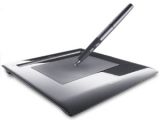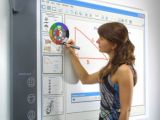As much as we've seen so far, visual and audio components prevail in today's PC peripherals. The tactile aspect of the direct interaction between man and PC seems to be dictated and thus limited by the keyboard and mouse models alongside their variations. However, there are some different ways to interact with your PC. Take, for example, the graphics artists, be they specialized in analog techniques or in CGI. The mouse can't really replace the analog painting and drawing devices when it comes to flexibility, so they demanded specialized electronic devices that would better simulate the real deal. Thus appeared the graphical tablets and a host of other similar devices.
Weapons of choice Just like keyboards and mice, graphics tablets are PC input devices. But apart from this resemblance, graphics tablets allow artists to hand-draw images and graphics, similar to the traditional way which implies pencils, brushes and paper.
Graphics tablets include flat surfaces upon which the user can draw, sketch or paint an image using a pen-like drawing device - the stylus. The drawn image does not appear on the work-area of the tablet itself because the stylus doesn't feature any material, like charcoal or gel that would leave traditional marks. Rather, the image is displayed on the computer monitor, inside compatible drawing programs.
The stylus, in its incipient stages, was designed as a part of the tablet electronics. Early graphics tablets, known as spark or acoustic tablets, used a sort of stylus that generated clicks with a spark plug. The clicks had to be triangulated by a series of microphones in order to locate the space coordinates of the pen. Systems like these were complex, bulky and expensive, with audio sensors susceptible to interference by external noise.
Later on, as technology progressed, the stylus took the form of a smooth and accurate pointed pen that would not damage the tablet surface while users drawn onto it. Introduced in 1964, the first graphics tablet resembling contemporary tablets was the RAND Tablet (Grafacon). This model employed a grid of wires under the surface of the pad, which encoded horizontal and vertical coordinates into a magnetic signal. The stylus would receive the magnetic signal, and the electronics recoded it into coordinate information.
The 1970s and 1980s introduced similar expensive models which were used only by CAD (computer-assisted design) initiates. The first PC graphics tablet was the KoalaPad, originally designed for the Apple II. It was quite a success back then and its compatibility was extended to most of the existent PCs with graphics support.
Following the original RAND Tablet design, current graphics tablets produced by companies such as Wacom make use of electromagnetic induction technology, where the horizontal and vertical wires of the tablet operate as both transmitting and receiving coils. The tablet generates an electromagnetic signal, which is received by an LC circuit in the pen. The wires in the tablet then change to a receiving mode and read the signal generated by the pen. Present-day variants also provide pressure sensitivity settings and one or more switches similar to the right and left buttons of a mouse. Unlike the original designs, the electronics for this information are present in the pen itself, not in the tablet.
Changing the pressure on the pen nub or pressing a switch changes the capacitance, which affects the signal generated by the pen. The use of electromagnetic signals enables the tablet to sense the stylus position without the stylus having to even touch the surface. In addition, all those devices that interact with the tablet do not require an energy source. However, these tablets tend to be quite expensive, can be susceptible to electromagnetic interference, and will not work without specifically designed proprietary styluses/devices.
Graphics tablets come in various sizes and prices that vary in concordance with the effective work-space. Thus an A6-sized tablet is relatively inexpensive, while an A3-sized tablet is far more expensive. All current tablet models usually connect to PCs via the USB interface.
Uuuu... what does this tablet do? As I've mentioned earlier, tablets that have the ability to detect pressure, tilt, and other attributes of the stylus, are the tool of choice for artists, because they provide a very natural way to create computer graphics, especially two-dimensional computer graphics. That is why many graphics software packages such as Corel Painter, Adobe Photoshop, The GIMP, ZBrush etc., are able to make use of the pressure and tilt information generated by a tablet. The program automatically changes attributes such as brush size, opacity, and color shade based on data received from the graphics tablet.
Graphics tablets still remain popular for technical drawings and CAD, as designers can put a piece of already drawn paper on the electronic device and transfer redraw the image without affecting the electromagnetic functions.
Chinese, Japanese and Korean characters (CJK) are usually introduced via graphics tablets and specially designed software programs that recognize such ideograms. Nowadays, tablets are more and more used as pointing devices, as they can be good replacements for PC mice. Think of using the stylus as a mouse and the tablet as a mouse-mat. And you don't even have to touch the tablet.
Alternatives Among the alternatives to graphics tablets, one may find interactive whiteboard devices and touch screens.
1. An interactive whiteboard is an electronic whiteboard writing surface which can capture writing and drawings electronically. These devices are mainly used in order to:
a) capture notes written on the whiteboard surface; b) control (click and drag) and annotate a computer-generated image displayed on (via projectors) or behind the touch surface; c)operate any software that is loaded onto the connected PC, including access to the internet via a web browser, eliminating thus the need for mice and keyboards.
These devices are most often used for educational purposes and come with special drivers that have to be loaded into the host PC. This driver converts detected contact with the interactive whiteboard into mouse clicks or digital ink. Besides this, there are six different types of interactive whiteboard that can control the PC: electromagnetic, analog-resistive, infrared optical, laser, ultra-sonic and camera-based (optical).
The most powerful interactive whiteboards have a wide active surface that not only captures annotations, but completely emulates the operation of software on a PC. This means that they can show pop ups, hints, hyperlinks and mouse-overs so that they overcome the limitations of touch sensitive resistive boards that are limited to an on/off action. The included whiteboard pens thus offer a mouse right-click function that is very useful in digital content and programs. This means they can write like a pen and control like a mouse.
2. Touch screens, touch panels or touchscreen panels are display overlays which have the ability to display and receive input information on the same screen. The effect of such overlays practically removes the need for a keyboard and/or the mouse as the primary input devices for interacting with the display's content. Such displays can be attached to computers, PDAs and cell-phones.
There is no widely adopted standard for these devices and one may encounter a whole bunch of manufacturing processes:
- Resistive technology - in this case, the screen is coated with a thin metallic electrically conductive and resistive layer that causes a change in the electrical current which is registered as a touch event and sent to the integrated controller for processing.
- Surface wave technology - uses ultrasonic waves that pass over the touchscreen panel. When the panel is touched, a portion of the wave is absorbed. This change in the ultrasonic waves registers the position of the touch event and sends this information to the controller for processing.
- Capacitive technology - the display is coated with a material, typically indium tin oxide that conducts a continuous electrical current across the sensor. The sensor therefore exhibits a precisely controlled field of stored electrons in both the horizontal and vertical axes - it achieves capacitance. This is also complemented by the quality of the human body which allows for electron storage.
- Infrared technology - this implies the existence of an array of vertical and horizontal IR sensors that detected the interruption of a modulated light beam near the surface of the screen. IR touch screens have the most durable surfaces and are used in many military applications that require improved interaction in rough conditions.
- Strain gauge technology - in such configurations, the screen is spring mounted on the four corners and strain gauges are used to determine deflection when the screen is touched. This technology can also measure the Z-axis.
- Optical imaging technology - this is a relatively-modern development in touch screen technology; two or more image sensors are placed around the edges (usually the corners) of the screen and infrared backlights are placed in the camera's field of view on the other sides of the screen. A touch shows up as a shadow and each pair of cameras can then be triangulated to locate the touch. This technology is growing in popularity, due to its scalability, versatility, and affordability, especially for larger units.
- Dispersive signal technology - it was introduced in 2002 and uses sensors to detect the mechanical energy in the glass that occurs due to a touch. Complex algorithms then interpret this information and provide the actual location of the touch.
- Acoustic Pulse Recognition - this is the latest development (2006) and it uses four piezoelectric transducers located at each side of the screen to turn the mechanical energy of a touch into an electronic signal. This signal is then converted into an audio file, and then compared to preexisting audio profile for every position on the screen. This system works without a grid of wires running through the screen, the touch screen itself is actually pure glass, giving it the optics and durability of the glass out of which it is made.
So, if the artist in you feels restricted by the use of awkward mice, you can make the jump to these ergonomic devices. Keep in mind that the wider the active work-surface is, the greater the price. Up next we have the digital projectors, so stay tuned.

 14 DAY TRIAL //
14 DAY TRIAL // 


